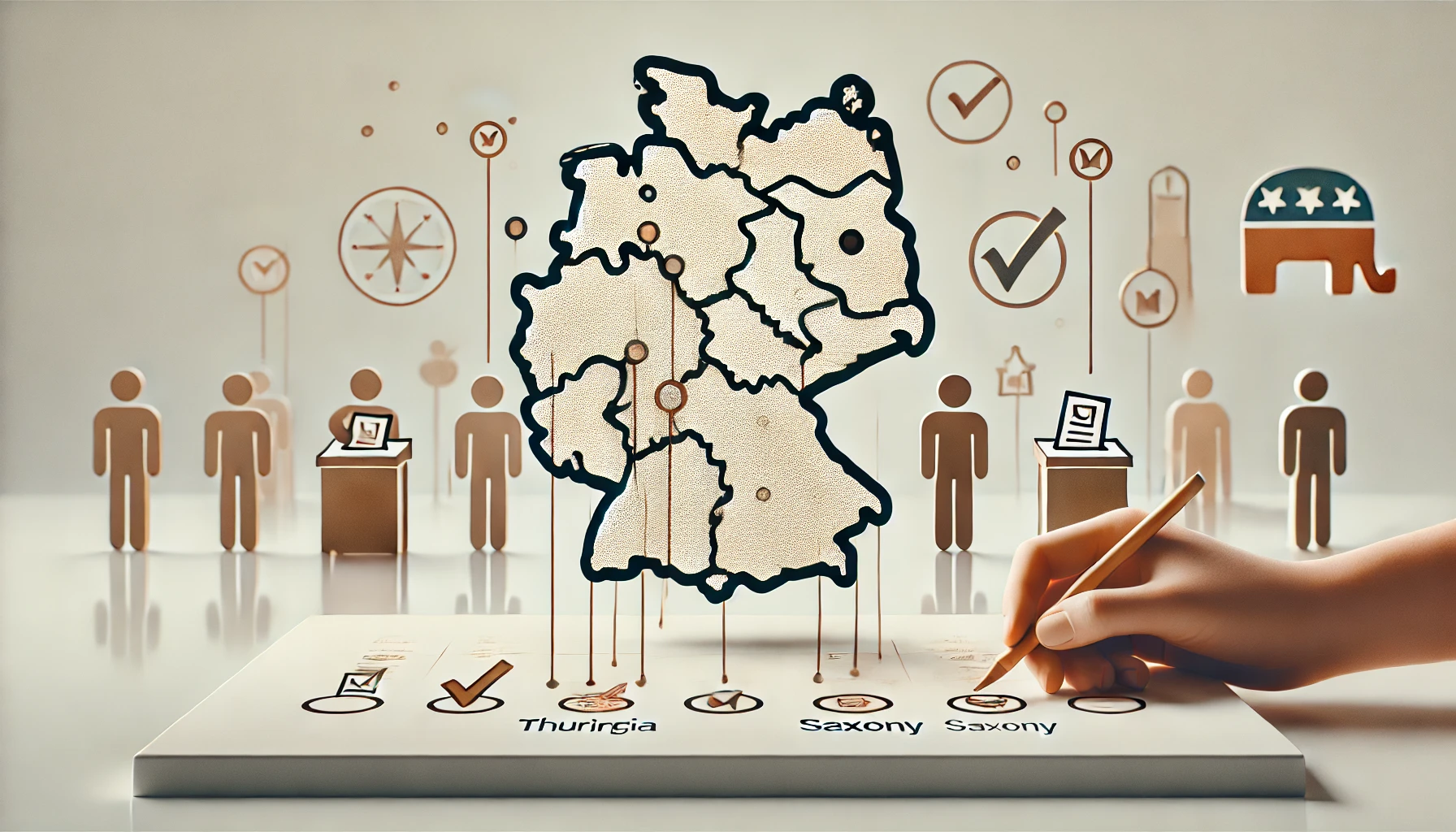Articles & News
- Home
- Blog
29. Agosto 2024
EU-Policy
Navigating the Political Shifts in Thuringia and Saxony’s State Elections

The upcoming state elections in Thuringia and Saxony on September 1st are shaping up to be pivotal moments in German politics. These elections are not just about who will govern these states—they could also signal broader changes in Germany’s political landscape, making them critical for anyone involved in public affairs.
The Significance of the Eastern State Elections
The importance of these elections stretches far beyond the borders of Thuringia and Saxony. Historically, results in these regions have served as indicators of larger trends across Germany, particularly in the former East Germany. The political dynamics here are unique, often diverging from those in the western parts of the country. Issues like migration, social justice, and the lingering impact of the former German Democratic Republic (GDR) continue to influence voter behavior in these areas.
Saxony, with a population of around 4 million, plays a particularly significant role on the national stage, while Thuringia, though smaller with 2.1 million citizens, is no less crucial. The outcomes in these states could shape the national political agenda, especially with federal elections looming in 2025.
The Rise of the AfD: A Game Changer
One of the most striking aspects of the current political landscape in these states is the rise of the Alternative für Deutschland (AfD). In Thuringia and Saxony, the AfD has taken on a more radical character, with the Office for the Protection of the Constitution officially classifying it as a confirmed right-wing extremist party. This makes the upcoming elections even more significant, and the results could signal how much influence the AfD will have moving forward.
Saxony’s Tight Race: CDU vs. AfD
In Saxony, the Christian Democratic Union (CDU) currently governs alongside the Greens and the Social Democrats (SPD) under Michael Kretschmer. However, the upcoming election is shaping up to be a fierce battle between the CDU and the AfD. Recent polls suggest the AfD is slightly ahead, with 32 percent of the vote compared to the CDU’s 30 percent. This narrow margin highlights the intense competition in the region, where the AfD has historically enjoyed strong support.
Adding to the complexity is the emergence of the Sahra Wagenknecht Alliance (BSW), a new party that combines both left-wing and right-wing populist viewpoints. With 15 percent in the polls, the BSW could become a significant player in Saxony’s state parliament, potentially influencing coalition negotiations after the election. Meanwhile, traditional parties like the SPD and the Greens are struggling to stay relevant, polling just above the critical five-percent threshold needed to secure seats in the parliament.
Thuringia’s Political Landscape: An Even Greater Challenge
Thuringia presents an even more challenging scenario. The state has been governed by a coalition of the Left Party, SPD, and Greens under Bodo Ramelow, but the AfD is now leading in the polls with 30 percent of the vote. The CDU trails behind at 21 percent, while the BSW is gaining ground, polling at 20 percent. The Left Party, which once held significant sway in the state, has seen its support crumble, now polling at just 14 percent.
For the parties in the federal “traffic light” coalition—SPD, Greens, and FDP—the outlook in Thuringia is even bleaker than in Saxony. The Greens and FDP are polling below the threshold needed to enter the state parliament, leaving them without representation. Even the SPD, which would barely secure seats with six percent of the vote, faces an uphill battle in forming a stable coalition without involving the AfD.
Recent Developments and Their Impact
The political climate has been further intensified by recent events, such as the knife attack in Solingen, North Rhine-Westphalia, on August 23rd which was claimed by ISIS. This incident, carried out by a Syrian asylum seeker who should have been deported to Bulgaria in 2023, has brought issues of migration and security to the forefront of the political debate. The AfD has seized on this event to advance its election campaign, proposing drastic measures like a moratorium on immigration and border closures. This could significantly impact voter sentiment in both Saxony and Thuringia, where the AfD already holds considerable influence.
Preparing for the Road Ahead
As the election date approaches, the political landscape in Thuringia and Saxony remains highly fragmented. Traditional alliances are under strain, and new political forces are emerging, making the formation of stable governing coalitions anything but straightforward. Recent shifts in the conversation around deportation and integration, even among traditionally pro-migration parties like the Greens, underscore how fluid and unpredictable the political discourse has become.
For public affairs professionals, these elections represent both a challenge and an opportunity. It is crucial to keep a close eye on these developments, as the outcomes will provide valuable insights into the electorate’s priorities and the direction of future policy-making in Germany. Understanding the local issues and how they resonate with voters will be key to navigating this complex political landscape effectively.
Conclusion: Staying Engaged and Informed
As Thuringia and Saxony prepare for these elections, those involved in public affairs should be ready to adapt to the changes that may come. This is a time to stay informed, engage thoughtfully, and prepare for the potential shifts that these elections could bring to both state and federal politics.
RPP will be actively monitoring the further developments in Saxony’s and Thuringia’s politics. If you have any questions, please feel free to contact us at any time.

Author:
Nora
Klein
Recenti Pubblicazioni
-
 06 Gen 2025State of Play: Italy’s 2025 Budget Law and Implications for Health Policy
06 Gen 2025State of Play: Italy’s 2025 Budget Law and Implications for Health Policy -
 18 Dic 2024State of Play: The Formation of the Belgian Government and Implications for Health Policy
18 Dic 2024State of Play: The Formation of the Belgian Government and Implications for Health Policy -
 10 Dic 2024Universal Healthcare: Bringing further equity and social justice for a better society.
10 Dic 2024Universal Healthcare: Bringing further equity and social justice for a better society. -
 26 Nov 2024Turning the Tide: Greece’s Cancer Plan as a Catalyst for Healthcare Reform
26 Nov 2024Turning the Tide: Greece’s Cancer Plan as a Catalyst for Healthcare Reform -
 20 Nov 2024Regional Elections in Emilia-Romagna, Umbria, and Liguria: shifting dynamics in Italian politics
20 Nov 2024Regional Elections in Emilia-Romagna, Umbria, and Liguria: shifting dynamics in Italian politics
